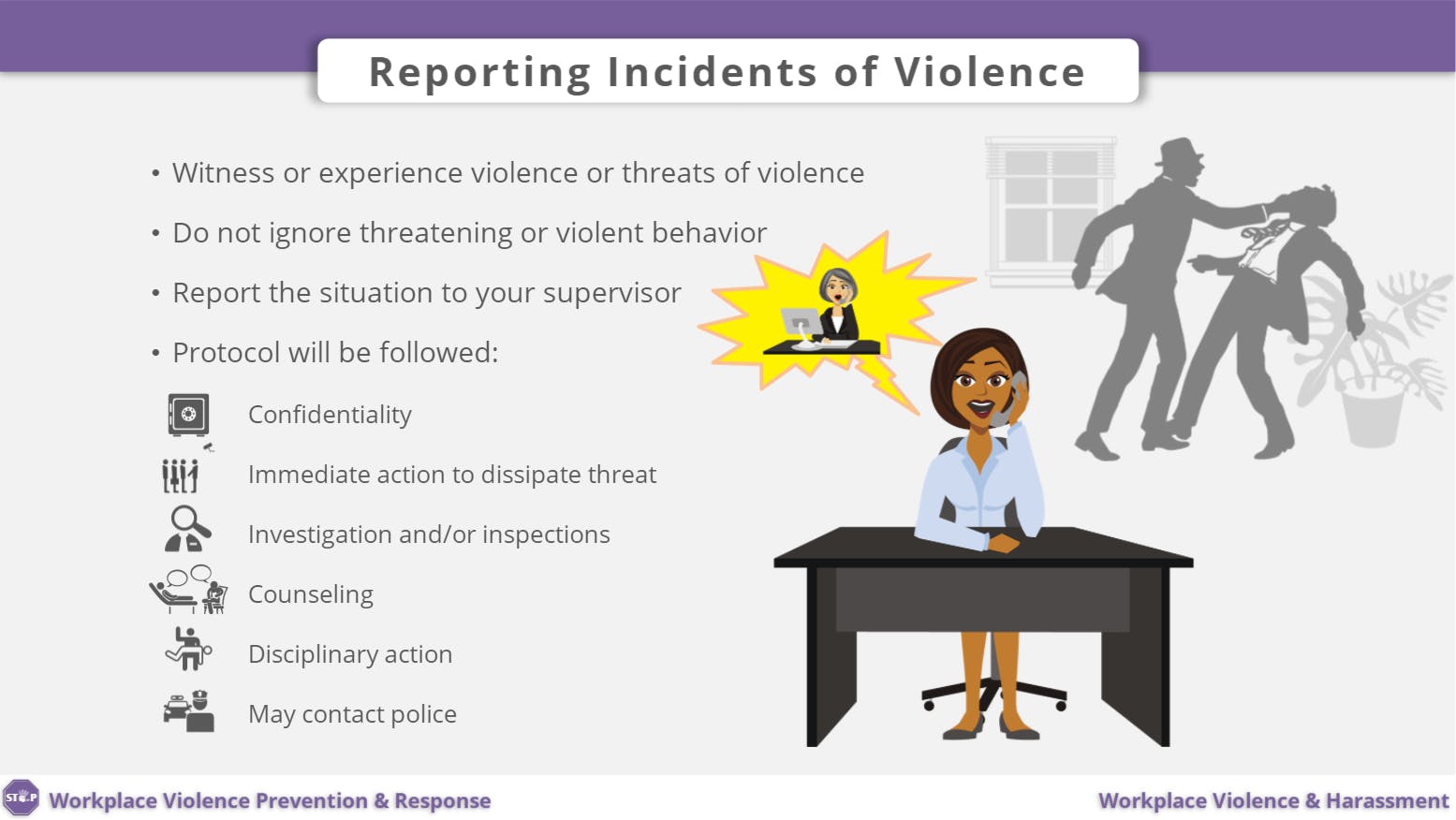Ingenious Tools and Resources for California Workplace Violence Prevention Success
Ingenious Tools and Resources for California Workplace Violence Prevention Success
Blog Article
The Function of Staff Member Training and Awareness in Enhancing Office Violence Prevention Initiatives Throughout Different Industries
The integration of worker training and recognition into work environment physical violence prevention efforts is increasingly identified as a fundamental aspect of business safety and security across diverse markets. By executing targeted training programs, businesses can efficiently equip their labor force to recognize and address prospective dangers before they intensify. Nonetheless, the effectiveness of these efforts usually depends upon several vital factors that vary by market, elevating vital questions about the adaptability of training methods and their real-world influence. Comprehending these subtleties may expose techniques that can substantially improve security protocols and worker confidence in risky settings.
Relevance of Training Programs
In today's dynamic workplace, the relevance of training programs can not be overstated, specifically in the context of work environment violence avoidance. These programs act as a foundational element in growing a safe and safe office society. By equipping workers with the understanding and abilities essential to recognize, minimize, and reply to possible risks, organizations can cultivate an atmosphere that prioritizes security and wellness.
Effective training programs do even more than merely instruct; they equip employees to acknowledge indication of violence, recognize the procedures for reporting cases, and develop methods to de-escalate potential disputes. They infuse a feeling of collective responsibility among team, urging aggressive participation in maintaining a risk-free office.
Financial investment in training not only enhances worker recognition however likewise shows a company's dedication to safeguarding its workforce. This proactive technique can lead to lowered cases of work environment physical violence, reduced absenteeism, and boosted worker spirits. Eventually, thorough training programs are integral to establishing a resilient organizational culture that values safety and promotes a healthy workplace, thereby minimizing the threat of physical violence and its linked effects.
Key Elements of Effective Recognition
An extensive understanding program encompasses numerous crucial elements that are important for effectively preventing workplace violence. Initially, clear communication of procedures and plans associated with workplace violence is crucial. Workers must be educated about the company's stance on physical violence and the particular methods in place for reporting cases.
Second, training sessions need to incorporate practical situations that staff members may run into. This useful approach assists employees acknowledge advising indications of possible violence and equips them with the essential skills to de-escalate strained scenarios. Third, fostering a helpful office culture is crucial; workers need to feel equipped to speak out without fear of retaliation.
Incorporating feedback devices enables employees to share their experiences and understandings, which can lead to continual renovation of recognition efforts. By integrating these components, organizations can develop a durable framework for avoiding workplace violence, inevitably adding to a much safer and more effective atmosphere for all employees (california workplace violence prevention).
Industry-Specific Training Strategies
Efficient office physical violence avoidance training should be tailored to the one-of-a-kind obstacles and risks faced by certain markets. For example, medical care atmospheres need training that addresses the high likelihood of experiences with hostile patients or visitors. Programs ought to concentrate on de-escalation strategies, identifying warning signs of possible violence, and making certain personnel understand the relevance of reporting cases.
In comparison, retail settings might face various threats, such as burglary or consumer conflicts. Training in these settings should highlight situational recognition, reaction methods during emergency situations, and the relevance of protecting money and prized possessions.
Manufacturing and construction industries present their own dangers, frequently connected with social disputes or unsafe working conditions. Training in these industries should include techniques for problem resolution, promoting a society of security, and motivating open interaction amongst employees.
In addition, corporate offices might require training fixated avoiding harassment and intimidation, cultivating a respectful work environment culture, and implementing clear reporting mechanisms. Each market should not only acknowledge its details vulnerabilities but also adapt training materials to resonate with the labor force effectively, ensuring that employees feel complete and encouraged to take care of possible terrible scenarios.
Gauging Educating Performance
Reviewing the impact of workplace physical violence avoidance training is critical for making certain that staff members are adequately prepared to handle possible hazards. To precisely determine training efficiency, organizations should apply both measurable and qualitative evaluation methods. Pre- and post-training studies can assess modifications in employee expertise, attitudes, and actions worrying workplace physical violence. These studies must focus on certain training goals to ensure placement with the organization's objectives.
Additionally, functional assessments, such as role-playing dig this situations or simulations, can provide understandings right into how well workers use learned abilities in real-life situations. Monitoring occurrence records before and after training can additionally act as a sign of efficiency, as a reduction in events may mirror enhanced staff member preparedness.
Moreover, responses from participants must be methodically collected to identify locations for renovation in training content and delivery. Conducting follow-up analyses at regular intervals assists endure recognition and reinforces training principles in time - california workplace violence prevention. By utilizing a detailed strategy to measuring training effectiveness, companies can guarantee that their work environment physical violence avoidance efforts cultivate a more secure environment and enhance overall employee well-being
Building a Culture of Safety And Security

Training plays an essential function in this social change. Normal, thorough training sessions enlighten staff members concerning identifying indication of workplace physical violence and the appropriate responses. Motivating open communication allows employees to voice problems without anxiety of revenge, advertising collective responsibility for security.
Furthermore, integrating safety and security right into everyday operations ensures that it comes to be a common value instead of a simple compliance concern. This includes regular safety and security drills, updates on plans, and feedback devices that include staff members in safety and security discussions and improvements.
Inevitably, a robust culture of safety and security helpful hints not only mitigates the dangers of workplace violence but additionally enhances staff member morale and productivity. By promoting an environment where safety and security is an essential top priority, organizations can develop durable offices that support both specific wellness and cumulative success.
Final Thought
In conclusion, employee training and recognition are important parts in the prevention of work environment violence across numerous industries. Efficient training programs, tailored to specific market demands, improve staff members' ability to respond and acknowledge to possible threats. By executing extensive understanding approaches and cultivating a society of security, organizations can dramatically lower events of work environment physical violence and improve general staff member morale. Commitment to continuous training and analysis guarantees sustained performance best site and flexibility in dealing with emerging difficulties within the workplace atmosphere.

Regular, comprehensive training sessions educate employees regarding acknowledging warning indications of workplace violence and the ideal feedbacks.In verdict, worker training and awareness are vital elements in the prevention of workplace physical violence throughout different industries.
Report this page